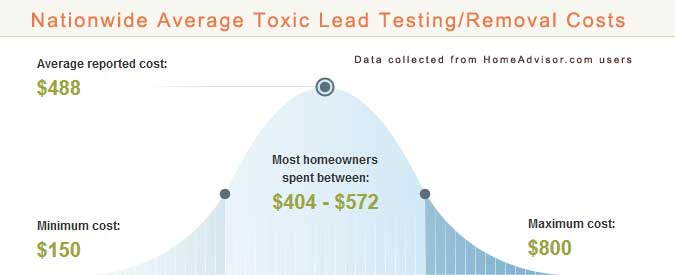Last Updated: February 15, 2023
Toxic Lead Testing and Removal Services Cost: How to Get Rid of Toxic Lead
Try Our Free Toxic Lead Removal Calculator
Fill out our 30 second free form to receive competitive pricing from pre-screened testing & removal companies. No commitments. Our service is always free!
Lead is a metal that naturally occurs in small amounts in the earth’s crust. It is dangerous and potentially deadly to humans and animals. No amount of lead exposure is safe for adults or children, but children are more vulnerable.
Prior to 1980, lead was widely used in consumer products such paint, ceramics, cosmetics, batteries, pipes and plumbing materials, and gasoline. Federal and state regulations have since greatly reduced the amount of lead in consumer products, but lead still poses a threat. Today, the most common sources of lead exposure include lead-based paint in older homes, household dust, contaminated soil (particularly from old industrial sites), drinking water and lead-glazed pottery.
Should I Have My Home Tested?
If your home was built before 1978, the U.S. Environmental Protection Agency (EPA) advises you to assume it has lead paint. For older homes, the EPA recommends testing for lead and fixing any potential lead hazards uncovered by that testing.

There are two types of tests:
- A paint inspection reveals the lead content of every painted surface in the home, but it does not tell you if the paint presents a hazard. A paint inspection also does not offer suggestions for how to deal with the lead paint in your home. This is the most common type of test when you are buying a home, renovating your home or signing a new lease.
- A risk assessment tells you if the lead in your home is dangerous and, if so, what to do to fix the problem. This kind of inspection reveals hazards such as chipped or peeling lead paint or lead dust in the home. This test is most often commissioned by families who are concerned about exposure to lead.
Keep in mind that lead paint is generally not dangerous when intact. Those who have lead paint in good condition can often just paint or wallpaper over the lead paint to keep it in place. If the lead paint has not been covered but is in good condition, the homeowner needs to be vigilant about keeping it that way. Tasks include regularly checking painted areas for signs of deterioration, removing paint chips and cleaning the area, and regularly washing floors and surfaces.
However, lead paint that is chipping, peeling or deteriorating is a serious health hazard that needs immediate attention. Lead paint on surfaces that children can chew on (i.e. windowsills and railings) is very dangerous, too, even if the paint is in good condition. In these cases, the lead paint must be removed or covered.
Try Our Free Toxic Lead Removal Calculator
Fill out our 30 second free form to receive competitive pricing from pre-screened testing & removal companies. No commitments. Our service is always free!
How Does Removal Work?
There are several ways to address a lead paint problem:
- Encapsulation is the simplest and least expensive. It involves applying a paint-like coating to keep the lead paint intact. However, this process is not permanent and will need to be repeated when the coating wears off.
- Enclosure involves covering the lead paint with a new surface. Walls with lead-paint can be covered with new drywall or windowsills can be covered with vinyl cladding. This method is effective unless you remove the new surface for some reason, exposing the lead paint.
- Removal, as the name suggests, involves removing the lead paint. There are several methods that can be used, including liquid paint removers, electric sanders and HEPA-filtered vacuums, or a low-temperature heat gun and scraping. This solution is more permanent than the others.
Addressing a lead paint problem is dangerous work, and removal is the most dangerous of the three solutions. Pregnant women and children should never be around when the work is in progress. Some people opt to tackle lead removal themselves, but the task is safer if left to the professionals.
How Much Will All of This Cost?
At-home test kits usually cost about $20 to $40. If you go this route, make sure the kit is EPA-recognized. Professional testing, which is generally safer and more reliable, costs about $200 to $500, depending on the size of the home or apartment.
Encapsulation, the least expensive method of addressing a lead paint problem, usually costs about $600 to $1,000 for materials alone. This is assuming you are encapsulating an entire home or apartment.
Removal usually costs about $8 to $15 per square foot, according to the EPA. That works out to $12,000 to $22,500 for a 1,500-square-foot home.
Should I Have My Water Tested?
Most water systems test for lead contamination as part of their overall water-quality monitoring. However, you should consider having your water tested for lead if your home has lead pipes or your plumbing was installed before 1986. At-home test kits usually sell for about $10 to $50.
Should I Have My Family Tested?
Elevated levels of lead in the blood are extremely hazardous to your health. However, lead poisoning is difficult to detect because there are often no symptoms. A simple blood test can reveal lead poisoning, so it’s a good idea to have your family tested if you’re concerned. Families who live in an areas with known soil contamination should be especially vigilant about testing.
Find the Best Testing & Removal Pros Who Will Compete for Your Business
Try Our Free Toxic Lead Removal Calculator
Fill out our 30 second free form to receive competitive pricing from pre-screened testing & removal companies. No commitments. Our service is always free!
Try Our Free Toxic Lead Removal Calculator
Fill out our 30 second free form to receive competitive pricing from pre-screened testing & removal companies. No commitments. Our service is always free!